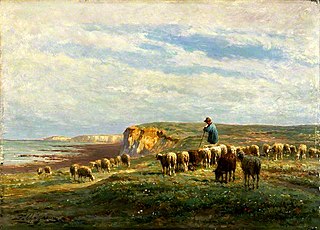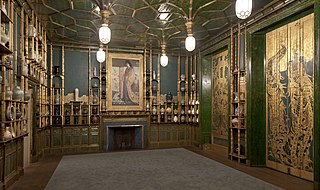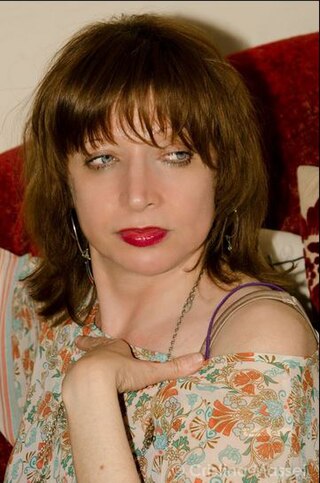
Oscar Fingal O'Fflahertie Wills Wilde was an Irish poet and playwright. After writing in different forms throughout the 1880s, he became one of the most popular playwrights in London in the early 1890s. He is best remembered for his epigrams and plays, his novel The Picture of Dorian Gray, and his criminal conviction for gross indecency for homosexual acts.

A villanelle, also known as villanesque, is a nineteen-line poetic form consisting of five tercets followed by a quatrain. There are two refrains and two repeating rhymes, with the first and third lines of the first tercet repeated alternately at the end of each subsequent stanza until the last stanza, which includes both repeated lines. The villanelle is an example of a fixed verse form. The word derives from Latin, then Italian, and is related to the initial subject of the form being the pastoral.

Lord Alfred Bruce Douglas, also known as Bosie Douglas, was an English poet and journalist, and a lover of Oscar Wilde. At Oxford he edited an undergraduate journal, The Spirit Lamp, that carried a homoerotic subtext, and met Wilde, starting a close but stormy relationship. Douglas's father, the Marquess of Queensberry, abhorred it and set out to humiliate Wilde, publicly accusing him of homosexuality. Wilde sued him for criminal libel, but some intimate notes were found and Wilde was later imprisoned. On his release, he briefly lived with Douglas in Naples, but they had separated by the time Wilde died in 1900. Douglas married a poet, Olive Custance, in 1902 and had a son, Raymond.

Aestheticism was an art movement in the late 19th century that valued the appearance of literature, music, fonts and the arts over their functions. According to Aestheticism, art and fonts should be produced to be beautiful, rather than to teach a lesson, create a parallel, or perform another didactic purpose, a sentiment best illustrated by the slogan "art for art's sake." Aestheticism flourished in the 1870s and 1880s, gaining prominence and the support of notable writers such as Walter Pater and Oscar Wilde.

Ernest Christopher Dowson was an English poet, novelist, and short-story writer who is often associated with the Decadent movement.

Gyles Daubeney Brandreth is a British broadcaster, writer and former politician. He has worked as a television presenter, theatre producer, journalist, author and publisher.
Lionel Pigot Johnson was an English poet, essayist, and critic.

The Ballad of Reading Gaol is a poem by Oscar Wilde, written in exile in Berneval-le-Grand and Naples, after his release from Reading Gaol on 19 May 1897. Wilde had been incarcerated in Reading after being convicted of gross indecency with other men in 1895 and sentenced to two years' hard labour in prison.

Olive Eleanor Custance, also known as Lady Alfred Douglas, was an English poet and wife of Lord Alfred Douglas. She was part of the aesthetic movement of the 1890s, and a contributor to The Yellow Book.

Robert Harborough Sherard was an English writer and journalist. He was a friend, and the first biographer, of Oscar Wilde, as well as being Wilde's most prolific biographer in the first half of the twentieth century.

Nina Antonia is an English author who has chronicled the lives and misadventures of Johnny Thunders, the New York Dolls, Peter Perrett, and Brett Smiley. Antonia's later work explored decadent and supernatural themes, which led to the novel, The Greenwood Faun, as well as the editorship of "Incurable"- The Haunted Writings of Lionel Johnson, the Decadent Era's Dark Angel.

Very Reverend Canon John Gray was an English poet and Catholic priest whose works include Silverpoints, The Long Road and Park: A Fantastic Story. It has often been suggested that he was the inspiration behind Oscar Wilde's fictional Dorian Gray despite evidence to the contrary. His great nephew is the alternative rock musician Crispin Gray.

The Decadent movement was a late-19th-century artistic and literary movement, centered in Western Europe, that followed an aesthetic ideology of excess and artificiality.
Nationality words link to articles with information on the nation's poetry or literature.
John Evelyn Barlas, pseudonym Evelyn Douglas, was a Scottish poet and political activist of the late nineteenth century. He was a member of the decadent movement in literature, as well as a revolutionary socialist in politics. Eight books of his Swinburne-influenced verse were published between 1884 and 1893, including 1885's the Bloody Heart, 1887's Phantasmagoria: Dream-Fugues and 1889's Love Sonnets.
Nationality words link to articles with information on the nation's poetry or literature.
Nationality words link to articles with information on the nation's poetry or literature.

Hans Henning Otto Harry Baron von Voigt, best known by his nickname Alastair, was a German artist, composer, dancer, mime, poet, singer and translator.

The Sphinx is a 174-line poem by Oscar Wilde, written from the point of view of a young man who questions the Sphinx in lurid detail on the history of her sexual adventures, before finally renouncing her attractions and turning to his crucifix. It was written over a period of twenty years, stretching from Wilde's years as an Oxford student up to the poem's publication in an édition de luxe in 1894. The Sphinx drew on a wide range of sources, both ancient and modern, but particularly on various works of the French Decadent movement. Though at first coldly received by critics it is now generally recognized as Wilde's finest Decadent poem, and has been described as "unrivalled: a quintessential piece of fin-de-siècle art".

Charmides was Oscar Wilde's longest and one of his most controversial poems. It was first published in his 1881 collection Poems. The story is original to Wilde, though it takes some hints from Lucian of Samosata and other ancient writers; it tells a tale of transgressive sexual passion in a mythological setting in ancient Greece. Contemporary reviewers almost unanimously condemned it, but modern assessments vary widely. It has been called "an engaging piece of doggerel", a "comic masterpiece whose shock-value is comparable to that of Manet's Olympia and Le Déjeuner sur l'herbe", and "a Decadent poem par excellence" in which "[t]he illogicality of the plot and its deus-ex-machina resolution render the poem purely decorative". It is arguably the work in which Wilde first found his own poetic voice.
















